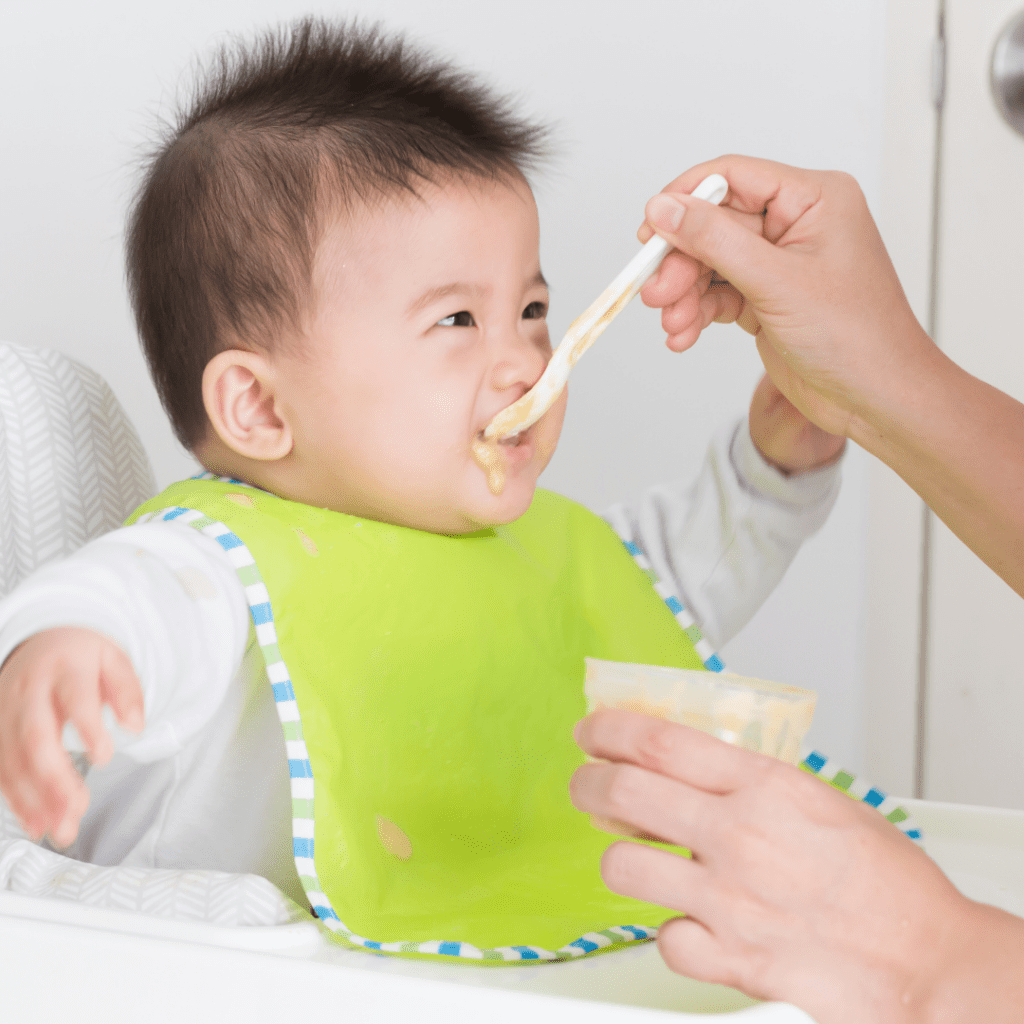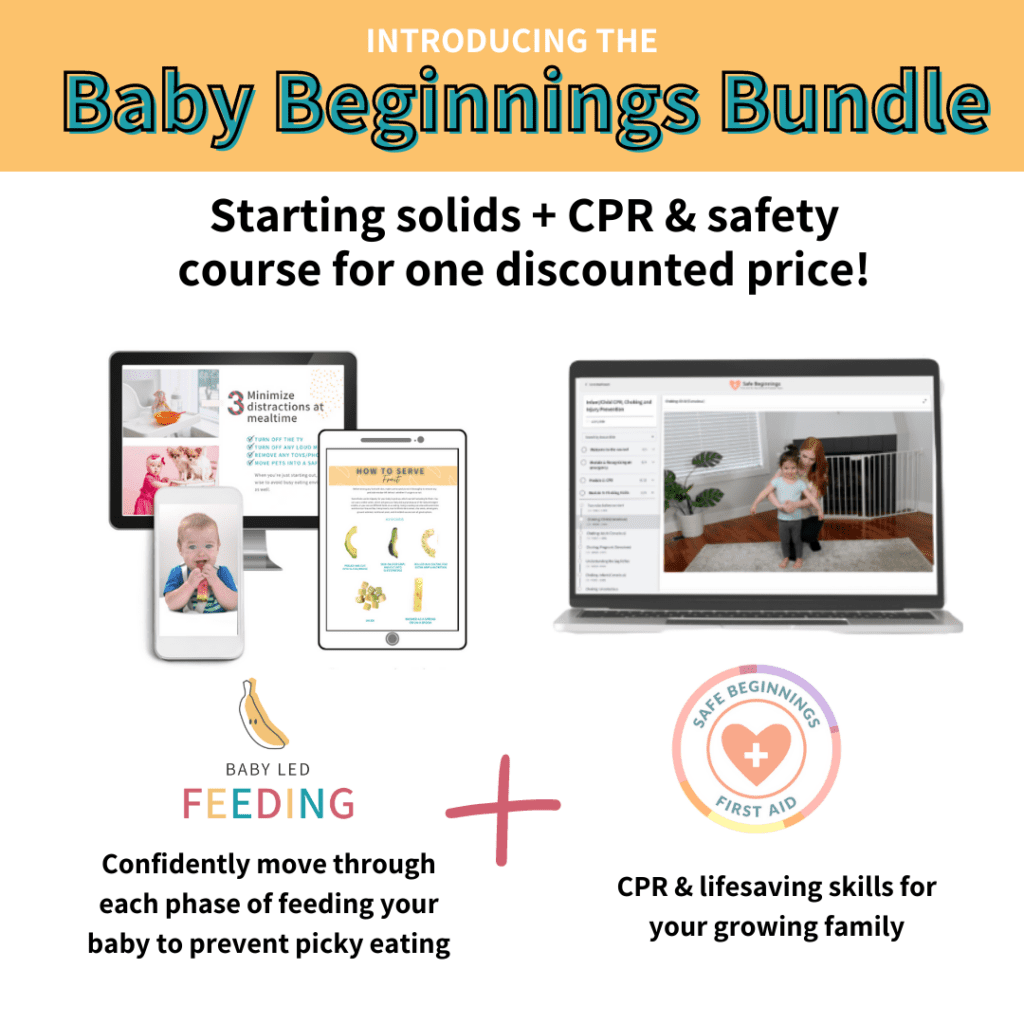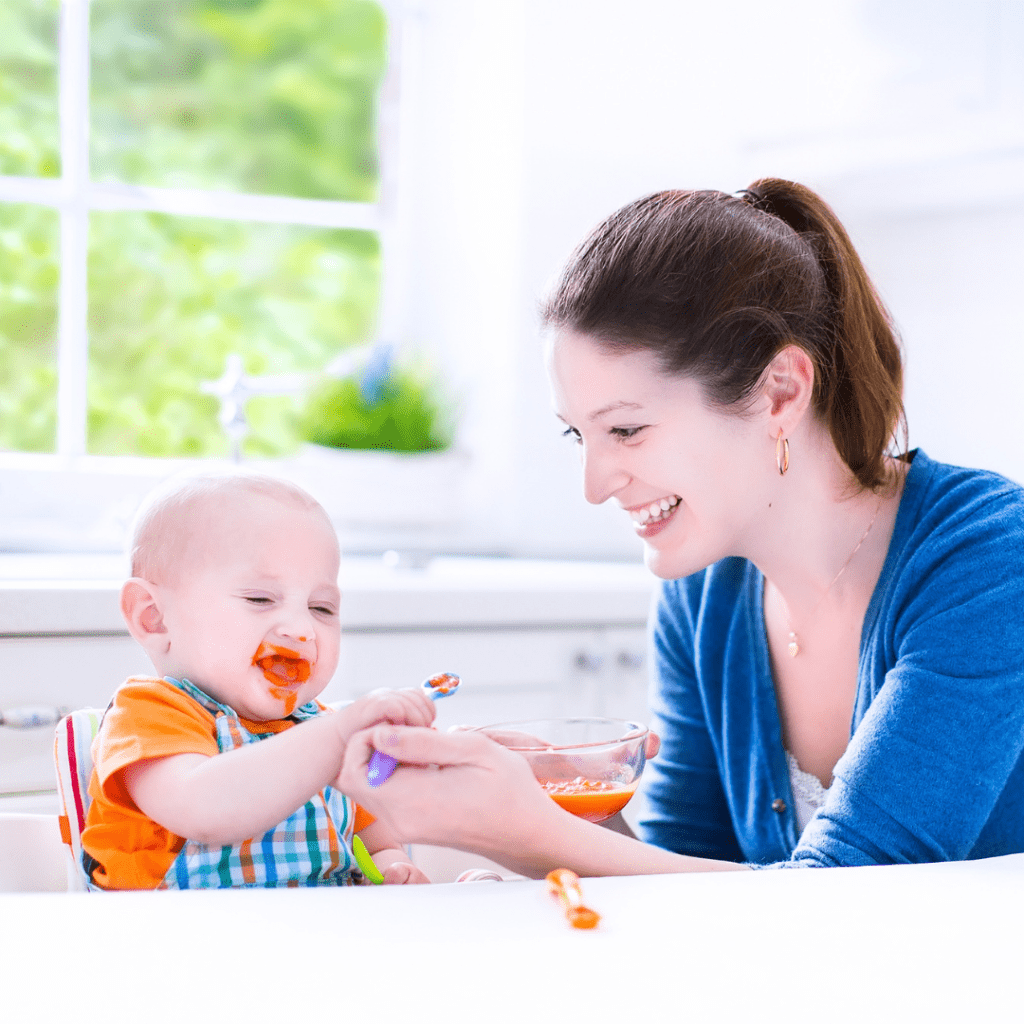This post may contain affiliate links, please view our disclosure policy for more details.
You may have been told by your doctor or pediatrician to go ahead and start purées at 4 months, with no real reason why…besides the fact that they’re 4 months old now! Your mother-in-law may argue that purées at 4 months is ok because that’s what she did and her kids turned out fine, or maybe you have an older child who started purées at 4 months and you’re wondering if the recommendations have changed.
At this point, you may be feeling hesitant, or your gut feeling is telling you that your little one isn’t ready to start on solid foods yet. So, naturally, you Google “When to start solids with baby”, and the results show you conflicting information with recommendations ranging from 4 months, between 4 to 6 months, or at 6 months of age. To a new parent, it seems like any one of these options is probably ok, but it’s not really clear if there is actually a better time to start than another.
The fact of the matter is that starting solids at 4 months – no matter whether starting with purées or finger foods – is not only outdated but is a blanket recommendation that doesn’t consider the individual needs and development of your little one.

Table of Contents
In this blog, we’ll debunk all the myths about why so many believe introducing solids at 4 months is appropriate, give you our recommendations for when you should start solids, and what you can do to help your baby get ready for solid food. Once you’ve read this blog, you’ll be able to confidently watch for all of the signs of readiness and help get your little one ready to start solids at around 6 months. So, let’s get started!
PS – If you’re at the point where your baby is getting ready to start solids and you want to find all the in-depth, research-backed info for feeding your baby all in one place, sign up for my Baby Led Feeding online course! Trusted by thousands of parents and experts worldwide, this course teaches you how to serve all foods safely using the feeding method that’s best for you and your baby, shows you how to progress through a variety of textures in a timely way with our signature Texture Timeline™ tool, and will have you confidently raising a healthy and happy eater!

Debunking the myths about why your baby should start purées at 4 months
There are a few different reasons as to why starting solids at 4 months seems to make sense, and is often recommended, but you may be wondering if those reasons are valid or not. Spoiler – we don’t actually recommend it for ANY of these reasons!
Myth #1: Your baby needs solid foods to gain more weight

If your baby is on the smaller side in terms of weight, you may have been told to start solids earlier (around 4 months old) to help with baby’s growth so they gain weight faster.
Not only is this completely false, but it could actually make the situation worse!
Introducing solid food to babies before 6 months means replacing a highly concentrated source of nutrients (breastmilk or formula) with a less concentrated form (infant cereal, fruit, or vegetables for example). Plus, purées tend to be watered down and do not provide as close to as many calories and nutrients as your little one would receive from breastmilk or formula.
Therefore, if you offer your baby solid foods too early, they might fill up on these less nutritious options and not drink as much breastmilk or formula, causing them to miss out on important nutrients, probiotics, antibodies, and energy which are vital for their optimal growth and development (1).
To be clear, from a nutritional perspective, there is absolutely no need to start solids earlier than 6 months of age – breastmilk or formula will provide all the nutrition they need until then. Recommendations indicate that up until 6 months old, babies should be exclusively breastfed (1).

My Little Eater’s Recommendation:
If your baby is struggling with weight gain, we encourage you to talk to your doctor about why this is happening to get to the root cause of the problem. Is it a poor latch that doesn’t allow them to extract milk efficiently? Are they not getting full feeds in for some reason? Or perhaps they aren’t absorbing the nutrients that are coming from breastmilk or formula and a referral to a gastroenterologist may be needed to determine any allergies, intolerances, or malabsorption issues.
Should there be a valid reason to add more calories, a better approach would be to use high-calorie formulas that are more balanced nutritionally, vs offering puréed fruits, veggies, or grains that provide little in the way of calories or specific nutrients needed for growth (2).
Myth #2: Starting your baby on infant cereal will help them sleep better

Despite current international recommendations from leading health organizations to start solids at around 6 months, many parents do believe that introducing baby cereal earlier, around 4 months old, will keep their babies full longer, and that in turn, they will sleep better.
And while it’s true that most babies sleep better when their bellies are full, there is actually no evidence out there to support introducing baby cereals around 4 or 5 months of age to help your baby sleep better (3).
Researchers have determined that introducing baby cereal at 5 months or earlier is actually associated with babies sleeping less throughout the night, and having a lower quality of sleep (3). This has to do with the fact that babies can experience digestive upset, gas, and constipation when solids are introduced too early. Your baby’s digestive system just isn’t ready, or mature enough, to digest anything except for breastmilk or formula this early on.

My Little Eater’s Recommendation:
So again, making sure your baby is having full feeds of breastmilk or formula is a more appropriate solution if you find they’re waking up too frequently from hunger.
Also please note, that up until 5 months of age, it’s normal for babies to still wake up once or twice throughout the night. Read more about the link between solids and sleep, here.
Myth #3: Introducing solids at 4 months is required to prevent allergies in all babies
You may have heard that the one exception to the rule of waiting until closer to 6 months to start solids is for babies who are considered to be at a higher risk for developing allergies.
This is actually true, and the Canadian Paediatric Society (CPS) and the American Academy of Pediatrics (AAP) recommend that for high-risk babies there may be a benefit to introducing highly allergenic foods earlier, between 4-6 months old, once they have begun to tolerate solid foods safely (4, 5, 6).

The Canadian Paediatric Society, the American Academy of Allergy, Asthma and Immunology and Dietitians of Canada identifies infants as high-risk for having an allergic reaction if they have an immediate relative with food allergies like a parent or a sibling, or if they have other allergic conditions like asthma, severe eczema, hay fever or another known allergy to food (6, 7, 8).
The recommendation of introducing common allergens earlier for high-risk babies is because research suggests that a “window of opportunity” may exist where babies develop a tolerance to certain allergens early on, particularly in relation to a potential peanut or egg allergy (4).
Note: This doesn’t mean that all solid foods should be introduced and regular daily meals be provided at 4 months of age!

We want to utilize this window of opportunity that may exist to introduce small amounts of top allergenic foods as early as possible, with the goal of them developing a tolerance to that food to avoid a long-term (or lifelong) food allergy. You’ll want to offer them a non-allergenic food to ensure they can tolerate it safely, if so, you can continue to introduce the top allergens only (remember, this is just to expose baby to the allergen, it’s not a full meal). Again, there is no need from a nutritional perspective to introduce full meals this early on, and the recommendation is to wait until closer to 6 months old.
Testing should be done by an allergist first, to determine if they’re allergic to the food or not. The allergist will give you guidance on how to proceed or will determine if further testing should be done before you go ahead and introduce the allergen to your little one through a food source (7).
Myth #4: Starting solids early is fine if you aren’t producing enough breastmilk to satisfy them

If your baby seems hungrier and unsatisfied at the end of a feeding, they may be going through a growth spurt, which typically happens around 3 months old (9). At this point, it is true that they may need more food to satisfy them, but you don’t need to introduce baby cereal or purées. They just need more of what they’re already getting, which should be breastmilk or formula.
The most common reason why mothers stop exclusive breastfeeding is that they think they aren’t producing enough breastmilk, but in fact, insufficient breastmilk production is rare (1). And although it may be rare, as a mom, you know your body and your baby best (so always choose what works best for you!).
If you are unable to produce enough breastmilk to satisfy your baby, you can opt to introduce an appropriate, nutritionally balanced formula instead of offering complementary foods too early, which is associated with potential negative outcomes. Keep reading for more details below!
Myth #5: It’s fine to start with purées at 4 months, so long as it’s not baby led weaning (finger foods)

Many times people assume that thin, smooth purées can be started early, around 4 months old, but that they should be waiting until that 6-month mark to do baby-led weaning and finger foods. Since purées do not require chewing or pressure at all to dissolve, like finger foods do, it seems like the safer option when just starting out. They simply go in baby’s mouth, get moved to the back with a suckle movement, and are swallowed.
But in fact, the risk of choking on finger foods is no different than the risk of choking on purées when the parents are properly educated on how to serve finger foods safely (10). Researchers came to this conclusion after studying the effects of a baby-led introduction to solids, in a popular research study known as “BLISS” (baby-led introduction to solids).
So while purées are technically easier for babies to suckle and swallow, they still aren’t considered safe for them this early on. Baby’s core support and oral skills associated with coordinated swallows are not fully developed yet (11). And just because some babies passively accept purées, doesn’t mean they’re safely in control, which all happens closer to 6 months.
Myth #6: My baby is showing interest in solids - they must be ready!

Parents get told to watch for their baby showing interest in solid foods because that’s when it’s time to start. Well, that’s partially true. Babies will begin to show interest in what you’re eating, usually around 4 months old.
But that’s not the only sign you need to look for! I hear from parents all the time that they were following their baby’s lead and observed that they were interested and ready for solids. While I love the idea of following their lead, I do want to make sure that it’s still safe for your little one, which is what all the other signs are for too.
So, while this is a good one to look for, you’ll want to ensure they have checked off ALL of the readiness signs that indicate they can safely begin before introducing solids.
Why have purées been introduced at 4 months in previous years?

The manufacturing of baby food by Gerber began a little over 100 years ago, in the 1920s. According to Amy Bentley, author of Inventing Baby Food, before baby food was even invented, babies were being fed strength-producing foods like cream of wheat and beef broth (12). At this time, other foods weren’t being introduced until much later, between 9-12 months of age (12).
Once the largest baby food company in the world, Gerber Baby Food, started mass producing canned, puréed baby food products, and advertising their products in nutrition journals, medical journals, and women’s magazines, the recommendations for introducing solids dropped down to as early as 5-8 weeks after birth in the 1950s (12). During this time, some doctors were even recommending that it was okay to introduce solids 24 hours after birth (12).
Canned or jarred baby food like purées or cereal was also marketed to make parents feel like it was a safer option than preparing their own purées at home. This took away some of the anxiety and worry about having to think about what food is best for your baby and how you should be safely preparing it (13).

During the 1970s and 80s, moms, doctors, pediatricians, and other health care professionals began to reevaluate the recommendations and conduct research studies to determine the best time to introduce complementary foods, in which the recommendations slowly pushed the age back up to 4-6 months (12). After many decades of conducting research studies, the recommendation is that most babies are showing signs of readiness to start solids at around 6 months.
Unfortunately, many doctors and pediatricians have not taken recent education in feeding, swallowing, nutrition, or oral development in the last few decades to stay up to date with the changing recommendations. So, while some doctors or pediatricians are still recommending introducing purées or cereal at around 4 months old, we now know this is a completely outdated and old recommendation.
Check out our Baby Led Feeding online course for the most up-to-date, research-backed information on introducing solids. It’s the only one on the market that includes a gradual approach to textures for both purées and finger foods using our exclusive Texture Timeline™. This timeline is developed by our team speech-language pathologist and uses a specific rubric to assess the ease of a texture, and the choking risk of a food, before recommending how to serve it in each phase.
When should you start solids with your baby?
Our recommendation of starting solids around 6 months of age is in line with the current guidelines from all of the leading health organizations including Health Canada, the AAP, World Health Organization (WHO), CPS, and the Center for Disease Control and Prevention (CDC) (1, 5, 6, 14, 15).

Now, the day your baby turns 6 months old, they won’t wake up and be magically ready to start eating solids. However, most babies are ready for solids around 6 months of age. For some, it could be 5.5 months or 6.5 months, and that’s why age isn’t the best indicator as to when they should actually start. Instead, it’s best to go off of what your baby can do, rather than start on the exact day they hit 6 months. We want to wait until they have developed each and every one of the readiness signs below.

The key is to truly understand and watch for all of the signs of readiness that your baby needs to demonstrate in order to be able to eat solids safely. Knowing your little one has checked off all the necessary developmental milestones is crucial to beginning solids at the right time for them.
To learn more about if your baby is ready for their first foods and to take a closer look at some of the specific signs of readiness that tend to cause a bit of confusion, check out our blog, here.
Risks of starting solids too early

Even though many people, including doctors and pediatricians, still believe that introducing purées at 4 months old is appropriate (and some even encourage it), we now know that not only is this not true, but too early an introduction can be associated with many negative effects, including:
- Increased risk of choking
- Babies drinking less than the recommended amount of breastmilk or formula
- Increased risk of obesity and diabetes
- Increased risk of digestive system issues and eczema
To learn more about the risks associated with starting solids too early and to read all of the nitty-gritty details, check out our blog, here.
What you can do at 4 months to prep baby for starting solids
Let your baby mouth their hands, toys, and teethers!

Allowing your baby to mouth on objects like teethers, toys, and even their hands is such an important part of their feeding development. Mouthing on objects helps your baby develop essential skills they’ll need later on in their feeding journey when they’re eating solids independently, these include:
- Hand-to-mouth coordination needed for independent feeding
- Moves a baby’s gag reflex further back in their mouth
- Reduces or prevents babies from being hypersensitive to food or longer objects (like a toothbrush) being in their mouth
- Advances tongue movements needed for when solids are introduced
- Advances jaw movement needed for removing food from a spoon, biting down, chewing, and cup drinking
Letting babies play with and mouth spoons (non-metal), toothbrushes or long teethers is totally safe and you can start offering these as early as 2-3 months old!
To find some of my favorite teethers to help with this, check out my Amazon shops for Canada and the United States.
Work on building baby’s core strength

To help prepare your baby for starting solids, you want to help them practice sitting upright. Giving baby lots of tummy time, and less time in car seats, swings, and jumpers, will help them with learning how to sit by developing core strength and posture stability. You can also help baby practice sitting by propping pillows around them on the floor and placing a toy directly in front of them in between their legs.
We encourage you to use a tool like the Upseat, which is perfect for helping babies sit up in the correct position, unlike some other infant seats on the market. This will also make the transition to a high chair, around 6 months when they start to eat, much smoother for them!
Give your baby sensory experiences

Learning to eat will involve A LOT of new texture experiences for baby!
We don’t want baby to be averse to new textures when they start solids or be afraid of getting messy as they explore new food. So, our advice is to let them touch and experience as many different textures as possible before they start eating solid foods.
You can let baby play in water, spread lotion on their body, and let them experience sensations like sitting on blankets with various textures, carpet, hardwood, grass, sand, etc.
This helps them become accustomed to having things on their skin and be less averse to the many odd and varied textures different solid foods provide – especially when it can be messy and get all over them!
Take an infant CPR class

You need an infant CPR course to be confident in how to safely deal with an emergency situation if the worst were to happen. It could save your child’s life (Edwena shares her experience and how she learned the hard way, here).
Get the infant CPR class done when your child is about 4 months old and have as many refresher infant CPR sessions as you think you need after that. Get confident in performing CPR before moving on to anything else because remember…the risk of choking is the same whether doing purées or finger foods!
Take a course on how to feed your baby solids

With the knowledge you need to save your child’s life in hand, you can now focus on the other aspects of starting solids. Begin our Baby Led Feeding course when your child is between 4-5 months old. Get to know what supplies you may (or may not) need, what foods to start with, how to safely serve all foods, nutritional needs for your baby, how to introduce allergens, and everything in between.
Plus, get access to our Texture Timeline™ video library to search any food and learn how to serve it based on the different phases of the timeline. This is the best resource for anyone looking to start solids because it includes both purées and finger foods so no matter how you’re looking to start, you can find the information you need. Find out more about the Baby Led Feeding online course, here.
This process will ensure that you’ve covered all the bases and are truly ready to start solid foods by around the 6 month mark – without rushing to get through the content or feeling lost in the process. No need to Google for hours on end every time you have a question, forget where you found what info, and waste your limited free time scrolling tips on Instagram. Learn it all in as little as 3 hours, at your own pace, and refresh as needed.
You can now bundle our Baby Led Feeding course PLUS the Safe Beginning’s top-rated Infant CPR & Injury Prevention course and save! Grab the Baby Beginnings Bundle for immediate and lifetime access to both courses.

LOVE IT? PIN IT TO SAVE FOR LATER!

References:
- Health Canada. Nutrition for healthy term infants: Recommendations from birth to six months. Retrieved from https://www.canada.ca/en/health-canada/services/canada-food-guide/resources/infant-feeding/nutrition-healthy-term-infants-recommendations-birth-six-months.html
- American Academy of Pediatric. Nutrition Supervision. Retrieved from https://downloads.aap.org/AAP/PDF/Bright%20Futures/BFNutrition3rdEditionSupervision.pdf
- Messayke, S., Davisse‐Paturet, C., Nicklaus, S., Dufourg, M. N., Charles, M. A., de Lauzon‐Guillain, B., & Plancoulaine, S. Infant feeding practices and sleep at 1 year of age in the nationwide ELFE cohort. Maternal & Child Nutrition, 17(1), e13072, 2021.
- Abrams, E. M., Watson, W., Vander Leek, T. K., Atkinson, A., Primeau, M. N., Francoeur, M. J., … & Chan, E. S. Dietary exposures and allergy prevention in high-risk infants. Allergy, Asthma & Clinical Immunology, 18(1), 1-7, 2022.
- American Academy of Pediatrics: Infant Food and Feeding. Retrieved from https://www.aap.org/en/patient-care/healthy-active-living-for-families/infant-food-and-feeding/
- Canadian Pediatric Society. Feeding your baby in the first year. Retrieved from https://caringforkids.cps.ca/handouts/pregnancy-and-babies/feeding_your_baby_in_the_first_year
- American Academy of Allergy, Asthma, and Immunology. Prevention of Allergies and Asthma in Children. Retrieved from https://www.aaaai.org/tools-for-the-public/conditions-library/allergies/prevention-of-allergies-and-asthma-in-children
- Food Allergy Canada. Early Introduction. Retrieved from https://foodallergycanada.ca/living-with-allergies/ongoing-allergy-management/parents-and-caregivers/early-introduction/
- WIC Breastfeeding Support. Cluster Feeding and Growth Spurts. Retrieved from https://wicbreastfeeding.fns.usda.gov/cluster-feeding-and-growth-spurts#:~:text=Your%20baby%20will%20go%20through,happen%20at%20these%20exact%20times
- Daniels, L., Heath, A. L. M., Williams, S. M., Cameron, S. L., Fleming, E. A., Taylor, B. J., … & Taylor, R. W. Baby-Led Introduction to SolidS (BLISS) study: a randomized controlled trial of a baby-led approach to complementary feeding. BMC pediatrics, 15(1), 1-15, 2015.
- Development stages in infant and toddler feeding. Retrieved from https://infantandtoddlerforum.org/media/upload/pdf-downloads/3.5_Developmental_Stages_in_Infant_and_Toddler_Feeding_NEW.pdf
- A. Bentley, Inventing Baby Food, University of California Press, 2014.
- Isaacs, A., Neve, K., & Hawkes, C. Why do parents use packaged infant foods when starting complementary feeding? Findings from phase one of a longitudinal qualitative study. BMC Public Health, 22(1), 1-11, 2022.
- World Health Organization: Complementary feeding. Retrieved from https://www.who.int/health-topics/complementary-feeding#tab=tab_1
- Centers for Disease Control and Prevention. When, What, and How to Introduce Solid Foods. Retrieved from https://www.cdc.gov/nutrition/infantandtoddlernutrition/foods-and-drinks/when-to-introduce-solid-foods.html

ABOUT THE AUTHOR
CHELSEY LANDRY, RD
Community Dietitian at My Little Eater Inc., and bunny-mom to Hickory. Chelsey offers one-on-one counselling to parents of babies and toddlers that need more customized support. Learn more by booking a free discovery call with her today!

ABOUT THE AUTHOR
CHELSEY LANDRY, RD
Community Dietitian at My Little Eater Inc., and bunny-mom to Hickory. Chelsey offers one-on-one counselling to parents of babies and toddlers that need more customized support. Learn more by booking a free discovery call with her today!









2 Comments
My baby is 4 months old and can sit upright hold his head lift himself with his elbows during tummy time has no tongue thrust reflex shows interest in food and brings objects to his mouth but you’re still telling me to wait? Even though he shows all the signs of being ready?
Great question! While it sounds like he’s showing all the developmental signs of readiness, from a nutrition perspective, babies don’t need anything other than breast milk or formula at this age and we want that to remain their sole source of nutrition until around 6 months. So we would still recommend waiting until closer to that age!